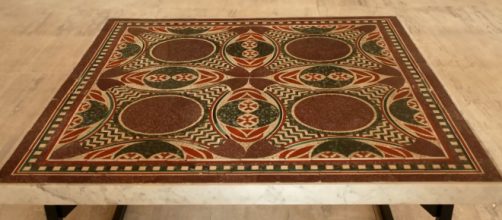You’ve probably heard of finding art treasures secreted away in attics and basement, but not likely in plain sight on a living room coffee table. The Guardian reports a long-lost Roman mosaic commissioned by Emperor Caligula for the floor of his lavish pleasure vessel sunk when he was assassinated, and now a tabletop in a New York apartment.
Unsuspected by the apartment dwellers, the relic was stolen. Ancient stone expert Dario Del Bufalo told of the discovery on CBS '60 Minutes' last Sunday. He said that in 2013 at a book signing for “Porphyry” – the reddish rock used by Roman emperors – a couple recognized the Caligula mosaic pictured in his book as their coffee tabletop.
'Innocent purchase'
The couple, Helen Fioratti, an art dealer, and her husband, an Italian journalist, told the New York Times they purchased the mosaic from “an Italian noble family in the 60s and turned it into a coffee table for their Manhattan home. “It was an innocent purchase,” Fioratti said.
According to the Manhattan district attorney, the mosaic was stolen by the Germans during WWII and later returned to Italy where it went on exhibit in the Museum of the Roman Ships. And that’s where the mosaic can now be seen again. “I felt very sorry for her,” said Del Bufalo who brought it back to Italy. He intends to make a copy for Fioratti.
Romancing the stone
Maybe Fioratti should give Del Bufalo’s offer a second thought considering it was made for the floating brothel where the sex-crazed Caligula romped.
According to Caligula’s contemporary Seneca the Younger, he not only slept with other men’s wives but also with his sisters. Not surprisingly, Fascist dictator Benito Mussolini wanted in on the emperor’s action. CBS News reports that he was so impressed with Caligula’s waywardness that he converted his palace into a brothel.
Over the years, many have tried and failed to raise Caligula’s ship. Renaissance architect Leon Battista Alberti famously tried in the 15th century. It’s no wonder he couldn’t given the ship’s 240-foot length, not to mention all its orchards and vineyards. And get this. Lead pipes that allowed running water in each room bore the emperor’s name like some designer label.
A watery grave wonder
Short of resurrecting the ship, divers brought relics from it to the surface. And according to CBS News, that’s when archaeologists spotted the mosaic. The New York Times quotes one of them, Rodolfo Lanciani wh said in 1898, “The deck must have been a marvelous sight to behold, and it goes beyond the power of imagination for its strength and elegance…"
But wait. Isn’t glorifying this thing a little like finding a treasure in the Fuhrer’s underground bunker and glorifying it because of who owned it? It’s not like the mosaic was art collected for its aesthetic value independent of who owned it. Caligula’s wantonness was the draw for Fascist dictator Benito Mussolini. As CBS News reported, he was so impressed with the emperor’s floating brothel that he converted his palace into one.


